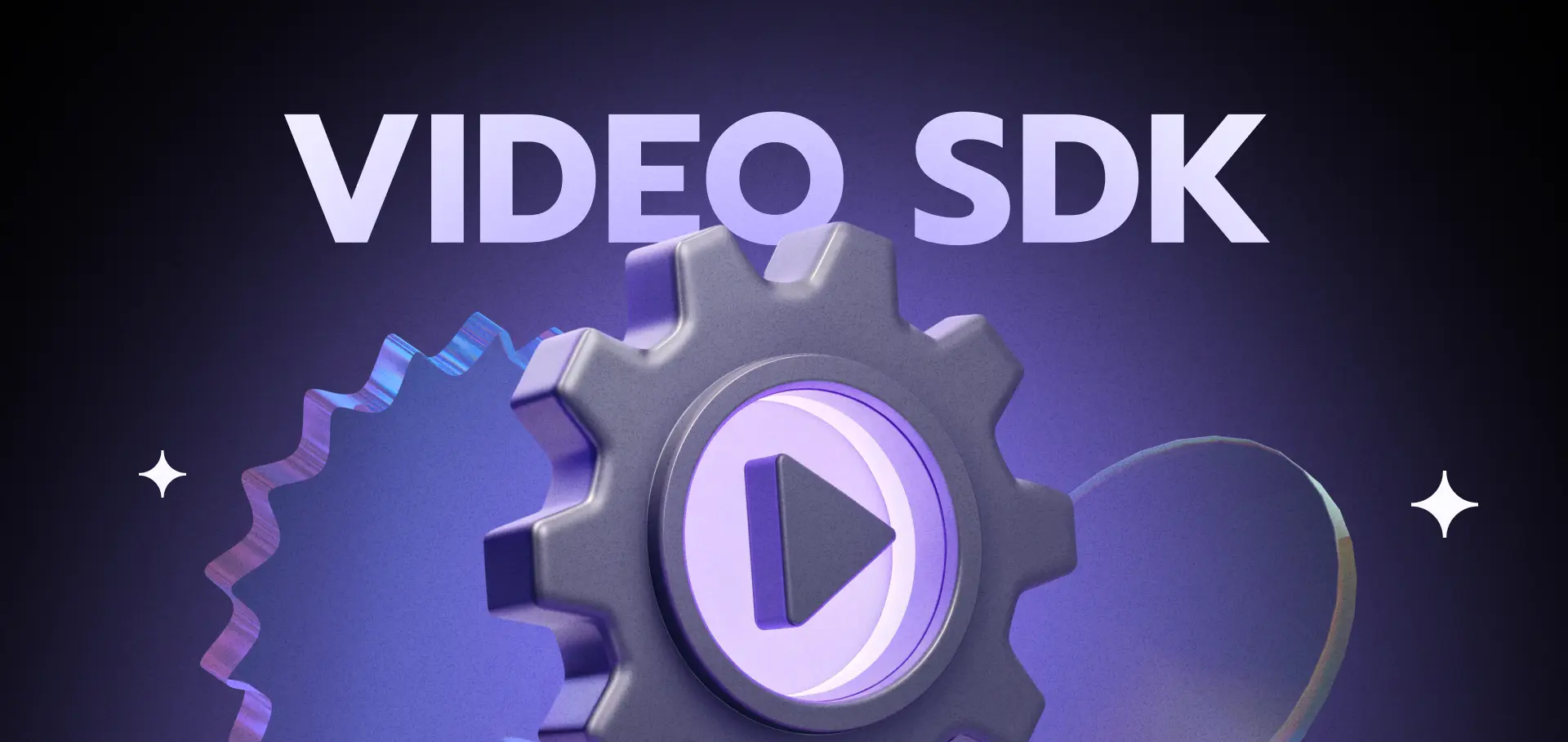
Building video features into your product doesn't have to be a headache. White-label video SDKs provide you with ready-made tools that save both development time and budget. Think of it as getting a complete video solution package: from user interface elements to media server infrastructure, all designed to help you create amazing experiences for your users.
The process begins by matching your security requirements and budget with available options. Once you select an SDK that meets your needs, you can add features step by step, testing them as you go. The right SDK partner can make a significant difference in your success. You'll want one that works well with your tech stack, includes the features your users need, and offers reliable help when you need it. Different providers offer various implementation schedules and support options, allowing you to find one that aligns with your project timeline.
Let's help you select the ideal white-label video SDK for your product.
Why Trust Our Video SDK Development Expertise?
At Fora Soft, we've been at the forefront of multimedia development since 2005, accumulating over 20 years of hands-on experience in video streaming solutions and SDK implementation. Our specialized focus on video surveillance, e-learning, and telemedicine platforms has given us deep insights into the complexities of white-label video SDK integration across various industries. With a proven track record of 100% project success rating on Upwork, we understand the nuances of video SDK development that many developers might overlook.
Our expertise spans multiple platforms, including web and mobile, as well as smart TV and VR headsets, utilizing cutting-edge technologies. This comprehensive experience allows us to provide practical, tested insights into white-label video SDK implementation. We've seen firsthand how choosing the wrong multimedia server can impact project timelines and budgets, which is why we're committed to sharing our knowledge to help you make informed decisions.
Understanding White Label Video SDK Development

You're looking to enhance your product with video features. White label video SDKs offer pre-built tools for that.
However, they differ from custom solutions in key ways.
What Makes White Label Video SDKs Different from Custom Solutions
When you look at white label video SDKs, you see a set of pre-built tools. These tools have a clear structure, comprising parts such as the user interface and the video processing engine. The modular nature of these tools enables companies with technical expertise to customize solutions while maintaining structural integrity effectively (Escudero et al., 2022).
Custom solutions, on the other hand, start from scratch, needing you to build each part yourself. This approach particularly benefits organizations with high levels of technical expertise, as they can better leverage the flexibility offered by modular design for enhanced customization (Escudero et al., 2022).
Core Technical Components and Architecture
Although custom video solutions offer tailored features, they often demand considerable resources and time. White label video SDKs, however, provide a pre-built foundation. You can quickly integrate video capabilities into your application.
The core components include a media server, signaling server, and client-side SDKs. These handle tasks like video encoding, real-time communication, and user interface management. Similar to how 45% of users prioritize trust and transparency in digital tools, the emphasis on robust user interface management ensures adoption success (Alodhyani et al., 2020).
This modular architecture ensures flexibility. You can customize the SDK to fit your needs without having to start from scratch. This approach saves both time and money.
It also allows for scalability and easy updates. You can focus on enhancing user experience rather than building infrastructure.
Implementing White Label Video SDK Solutions
You start by planning your integration process. Each step builds on the last, so you can't skip any.
You'll first set up the environment, then add the SDK, and finally test each feature.
Step-by-Step Integration Process
When integrating a white label video SDK, you'll first need to understand the security and compliance requirements. These requirements can vary greatly depending on your region and industry.
For instance, healthcare apps must adhere to strict data protection rules, such as HIPAA, in the US.
Next, review the cost breakdown. Many SDKs have hidden fees that can add up quickly. A detailed cost analysis helps you see the actual expense.
Finally, you'll need to consider the return on investment (ROI). Some companies find that investing in a white label video SDK boosts user engagement considerably. Research indicates that organizations implementing video SDKs typically experience notable improvements in user engagement metrics, although it's essential to base expectations on industry-specific data (Zhou et al., 2024).
Security and Compliance Requirements
As you immerse yourself in implementing white label video SDK solutions, security and compliance requirements stand as non-negotiable pillars. You must guarantee your SDK meets industry standards.
Data encryption is vital. Regularly update your SDK to fix security gaps.
Compliance with data protection laws is mandatory. Conduct frequent security audits.
Educate your team about security best practices. Users trust services that prioritize security.
Cost Breakdown and ROI Analysis
Implementing a white label video SDK solution involves a considerable investment. You'll need to account for video SDK pricing, which varies based on features and usage.
Developing a white-label SaaS product requires ongoing costs, such as maintenance and updates. However, the potential returns can be substantial.
Many companies see a notable ROI within the first year. Clear budgeting helps manage expectations and allocate resources effectively.
Break down costs into initial development, licensing fees, and operational expenses. This approach provides a realistic view of your financial commitment.
Selecting the Right White Label Video SDK Partner
When selecting a white label video SDK partner, you start by checking their technical skills.
You look at how quickly they can finish the job.
You should also consider how well they can assist you after the project is complete.
Technical Evaluation Criteria
Selecting a white-label video SDK partner is crucial for the success of your product. You need to evaluate potential partners based on clear technical criteria. This guarantees that the video SDK meets your needs.
First, check the SDK's compatibility. It should integrate seamlessly with your existing tech stack. This includes the programming languages and platforms you use. Next, look at the SDK's features. Ensure it has all the video functionalities you need. For example, check if it supports real-time communication or video recording.
Then, consider the SDK's performance. It should handle high-quality video without lag. Additionally, review the SDK's security features. It should protect user data. Finally, think about the support and documentation. Good support helps you solve problems quickly.
Here is a table to help you evaluate:
Evaluate each partner carefully. Use this table as a guide. This guarantees you pick the right SDK for your product.
Implementation Timeline and Support Structure
After you've narrowed down your choices based on technical criteria, you must consider the implementation timeline and support structure of each SDK partner. Understanding the SDK's meaning is vital. It's the set of tools that lets you integrate video features into your app.
Each partner has a different timeline for this integration. Some might get your white label product ready in weeks, others might take months.
Support structures also vary. Some partners offer 24/7 support, while others have limited hours of operation. Consider a partner that provides clear documentation and frequent updates.
One company achieved a 30% faster integration time because its SDK partner provided strong support and clear guidelines.
Don't overlook the trial period. It lets you test the SDK and the partner's support before committing.
Seek partners that provide a dedicated support manager. They can address your concerns quickly and personally.
🎯 Interactive SDK Feature Prioritizer
Not sure which video SDK features matter most for your product? Use this interactive tool to prioritize features based on your industry and use case. Select your product type and see which capabilities you should prioritize when evaluating white label video SDK partners.
Frequently Asked Questions
What Are the Legal Considerations for White Labeling?
You'll need to ensure that you have the necessary rights to white-label the software, create clear user agreements, protect user data, and comply with licensing laws. Consult with a legal expert to cover all bases.
How Do I Market My White Labeled Video SDK?
You'll want to identify your target audience first. Emphasize the benefits of seamless integration, custom branding, and time-saving features. Utilize industry-specific platforms, content marketing, and case studies to show real-world success. Engage with potential clients through webinars, demos, and targeted ads. Ensure your messaging emphasizes the ease of use and quick deployment.
What Are the Ongoing Maintenance Requirements?
You'll need to regularly update the SDK to support new OS versions, add new features, fix bugs, maintain documentation, and provide customer support. Make certain you monitor performance, security, and address any user feedback. Conduct periodic testing to catch issues early.
How Can I Monetize My White Labeled Video SDK?
You can monetize your white labeled video SDK by charging licensing fees, offering subscription-based pricing, or providing premium features for an additional cost. Consider partnering with companies for revenue sharing or offering custom development services for a fee. Explore integrating ads within the SDK or offering a freemium model where basic features are free, but advanced ones require payment.
What Are the Potential Challenges in Customer Support?
You'll face challenges such as handling diverse customer queries, providing timely support across multiple time zones, managing bug reports, and addressing feature requests. Balancing support for your SDK and clients' end-users can also be tough. You may struggle with scaling support as your customer base grows, ensuring all users have access to prompt and accurate help. Maintaining clear, up-to-date documentation is essential yet demanding. Expect challenges in supporting customized implementations and addressing conflicting customer expectations.
Conclusion
By 2026, white-label video SDKs will be essential for product owners. They allow you to add video features without having to build from scratch. You pick the features, and the SDK handles the rest. This saves time and money. Additionally, you can focus on making your product stand out. Just choose your SDK partner wisely. Check their technical skills and support. Follow the integration steps closely. You'll see your product improve quickly.
References
Alodhyani, F., Theodorakopoulos, G., & Reinecke, P. (2020). Password managers—it's all about trust and transparency. Future Internet, 12(11), 189. https://doi.org/10.3390/fi12110189
Escudero, A., Izquierdo, C., & Redondo, M. (2022). Towards profitable customized solutions in small firms: A matter of relationships, modularity and expertise. Journal of Business and Industrial Marketing, 38(1), 137-154. https://doi.org/10.1108/jbim-03-2021-0147
Zhou, P., Wang, L., Liu, Z., et al. (2024). A survey on generative AI and LLM for video generation, understanding, and streaming. https://doi.org/10.36227/techrxiv.171172801.19993069/v1













.avif)

Comments